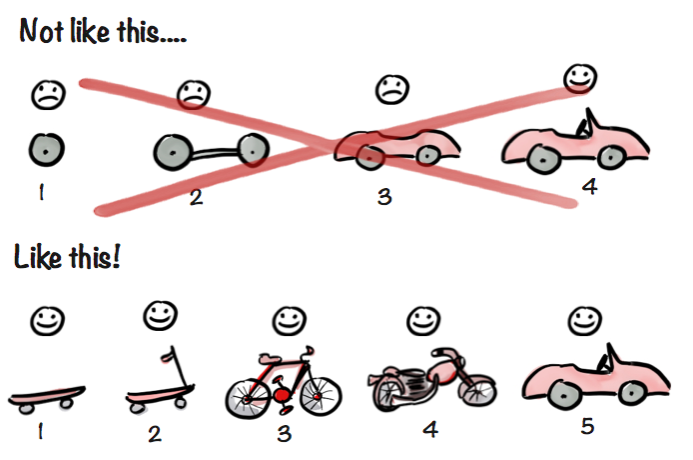This is an Eval Central archive copy, find the original at winderl.net.
MINIMUM WHAT?!?
Ok. What are we talking about?
A minimum viable product – MVP in short – is a product with just enough features to gather validated learning about a possible intervention or product. It is deliberately imperfect; any additional work on it beyond what was required to start learning is waste, no matter how important it might have seemed at the time.
The idea of using minimum viable products is taken from product development ideas of the lean start-up movement in the private sector. The most well know writer about lean startup movement is probably Eric Ries with his book on ‘The lean startup: how constant innovation creates radically successful businesses’ (1).
The underlying reason to develop an MVP is to empirically test assumptions and hypotheses about what works and what does not. Using MVPs is a structured way to check that you have an efficient and appropriate solution or approach before rolling it out or making a big investment in it.
Minimum viable product can range in complexity from extremely simple ‘smoke tests’ (little more than an announcement or advertisement for a service or product) to actual early prototypes complete with problems and missing features.

Source: Stop overthinking…Just stop!, Matias Honorato
WHEN TO USE IT
Minimum viable products are the fastest way to get through the build-measure-learn feedback loop of adaptive programming (see section on adaptive programming). The goal of MVPs is to begin the process of learning, not end it. Unlike ‘prototypes’ or ‘proofs-of-concept’, MVPs are designed not just to answer product design or technical questions, but to test out theories of change and fundamental development hypotheses.
Some forms of minimum viable products to consider are:
- Video MVP: simple, short video that demonstrates how a programme, project, policy, product or service is meant to work
- ‘Concierge’ MVP: testing a programme, project, policy, product or service is meant to work with a single or very few clients
- ‘Wizard of Oz’ MVP: clients believe to be interacting with an actual service or product, which is in fact only simulated by humans
AN EXAMPLE
In Papua New Guinea, UNDP tested whether a low-cost tool can help the government address corruption and mismanagement, which gobbled up 40% of the country’s annual budget. In 2014, UNDP partnered with local Telecom companies to design a simple SMS-based minimum viable product. The MVP was subsequently tested with 1,200 staff in the Department of Finance, and updated based on user-feedback. Within four months, it led to over 250 cases of alleged corruption under investigation. Based on the uptake of the first version, the service was rolled out to six new departments and 25,000 government officials countrywide in 2015. (2)
For examples from a business start-up perspective see e.g. The Ultimate guide to minimum viable products by Scale up my Business.
———————————————–
This blog post is based on: The lean startup: how constant innovation creates radically successful businesses, Eric Ries, 2011, pp.92-113; Minimum viable product (MVP), Wikipedia; Prototype testing plan, Development Impact & You (DIY)
Sources:
(1) The lean startup: how constant innovation creates radically successful businesses, Eric Ries (2011)
(2) 6 ways to innovate for 2030, Benjamin Kumpf, 19-04-2016; Papua New Guinea: Phones against corruption, UNDP
The post Stop overthinking: Minimum Viable Product appeared first on Thomas Winderl.